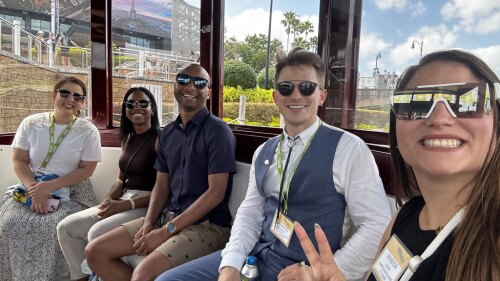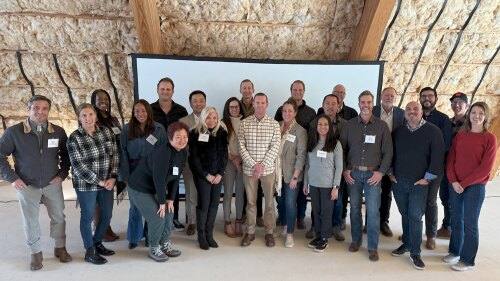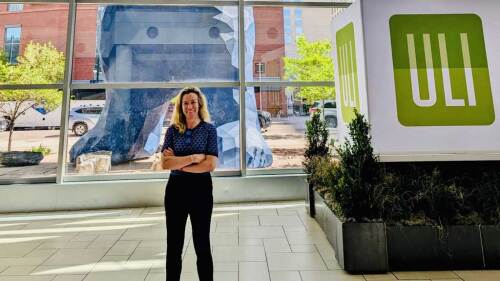The ULI/Randall Lewis Health Mentorship Programallows students to learn about the Institute, develop relationships with members, and deepen their understanding of opportunities to advance health through careers in the land use industry. The program pairs exceptional current graduate students with ULI members working at the intersection of health and the built environment.
In fall 2021, the Building Healthy Places Initiative brought together mentors and mentees from Cohort 3 (2019-2020) and Cohort 4 (2021-2022) in Chicago, where mentees attended programming and Product Council meetings alongside their mentors. Here, mentees from both cohorts share their top takeaways for health and social equity in real estate from the 2021 Fall Meeting.
Are you a Full Member on a product council who would like to serve as a mentor in a future cohort? Email us at [email protected] or learn more on Navigator.
How did the 2021 ULI Fall Meeting make you think differently about health and social equity in real estate?
Aleiya Als, Cohort 4: The Fall Meeting made me think about health and social equity beyond just my profession by giving me insight into other professions through the meetings and discussions held.
Miguel Castro Jr, Cohort 4: The Fall Meeting has opened my eyes to how much there is that needs to be considered for the built environment. Being a graduate student who will be entering the profession of architecture with a focus on property and real estate development, the Fall Meeting has been critical in providing me with an understanding about all the different moving parts that make the built environment possible, but more importantly healthy.
Miluska Franco, Cohort 4: A healthier and more equitable environment can be created through increasing homeownership, creating accessible health services, and above all prioritizing a community’s role in the creation of these healthy spaces. Before the Fall Meeting, I didn’t understand how expansive and personal real estate’s role can be in providing equity. I didn’t see change through real estate as a community led opportunity. I’m pleased to say I do now.
Evelyn Mayo, Cohort 4: As a planner, I came into the Fall Meeting with little baseline for health and social equity in the context of real estate. After participating in the meeting, I think about real estate, collective ownership, creation of anchor institutions as a necessary piece of the broader neighborhood-wide ecosystem that I generally focus on.
Amelie Rives, Cohort 4: The Fall Meeting in Chicago provided an opportunity to see real estate and development through many different lenses. Goals for impacting the environment, placemaking, equitable development, community engagement, etc., all contribute to real estate professionals’ connection to the built environment and household health and wellness.
Natalia Chavez, Cohort 3: The Fall Meeting had me reflect on how much more the industry has to go to fully address health and social equity, but also hopeful for the future because of the champions who continue to bring light to these issues within real estate.
Jasmine Jones-Bynes, Cohort 3: At ULI Fall Meeting 2021 in Chicago I learned ways that health and social equity can be built into the prospectus of a real estate deal either through location (e.g. proximity to services), building amenities (e.g. gyms in mixed income and affordable units), and/or property management services.
Emma Stockton, Cohort 3: Fall Meeting showed me many concrete examples of how real estate, which provides places to live, work, shop, play, etc., is so interconnected with the social determinants of health, a large part of which is influenced by social equity. The meeting showed me that this work is actually being implemented on the ground which was so exciting!
What was the most impactful session/tour/forum that you attended/participated in, and why?
Als: The Randall Lewis/Building Healthy Places Forum. I loved the research and connection that the keynote speaker [Dr. David Ansell] discussed within the health profession and wanting to make a difference, and how he did that through his profession.
Castro Jr: The Residential Neighborhood Development Council (RNDC) day was the most impactful forum that I attended for several reasons. Some of the reasons is the quality and focus of the information that was provided. The last presentation was a deep dive into what the future of the American Home may look like after taking into consideration the impact COVID has had on all our lives. The presentation on the American Home Study Concept Home was a game changer for me. The research methods used in the research directly related to the studio work I am currently working on in class. It made the argument for really listening to the clients and people for the little details about what they are or are not looking for in a home. I was able to apply to my life the lessons learned at this portion of the Fall meeting immediately.
Franco: David Ansell, MD, the speaker from the first day of the Building Healthy Places Forum. His session set the tone for the conference, that all professionals aware of inequitable practices can and should lead the change towards healthier, socially equitable environments. Although Dr. Ansell is not in the field, it was wise to include him to teach us the importance of collaborating with other professionals in community building. The passion and action he has towards the injustice in the health care system is inspiring.
Mayo: The most impactful tour I participated in was the Chinatown tour. The tour was impactful because it was led by two people who had personal connections to the neighborhood and were involved in various community-based projects that we heard about and visited in the neighborhood. To me, healthy places are places with self-determination and active democratic engagement about social equity, preservation and community empowerment, and this tour helped engage the changes in Chinatown really well.
Rives: The Reuse and Redevelopment Product Council Day, which I attended with my mentor was extremely enlightening. A session on a development in the Englewood neighborhood in Chicago was especially impactful for me. It was clear that community members have been involved since the thought-stage of the project and have influenced its direction through each development stage. This strikes me as the most equitable solution to revitalization efforts and I was impressed at the connection that real estate can make with communities when neighbors are engaged intentionally.
Chavez: The most impactful session was the presentation by Dr. Ansell [during the Randall Lewis/Building Healthy Places Forum]. He is directly involved in health equity work as the Senior Vice President for Community Health Equity at Rush University. He started seeing the connection between where his patients lived and their life expectancy while Chair of the Department of Internal Medicine at Mount Sinai Hospital, located in one of the highest hardship communities in Chicago. Dr. Ansell presented data on how life expectancy is drastically dictated by where someone lives. His session was impactful and I look forward to reading his book The Death Gap: How Inequality Kills.
Jones-Bynes: I attended the session “Can eTOD’s Holistic Approach Help Solve a City’s Affordable Housing Problem?” which highlighted a transit-oriented development project in the Bronzeville neighborhood on Chicago’s south side. The panelists discussed the complex capital structure that was needed to make a transit-oriented development in a redeveloping community feasible. The project featured Tax Increment Financing (TIF), New Market Tax Credits, Low-Income Housing Tax Credits, Community Development Block Grants and other financing tools. My biggest takeaway from the session was the demonstrated need and demand for government subsidy and incentive programs in multifamily affordable and mixed-income real estate.
Stockton: I truly loved all the sessions I participated in, but Maurice Cox’s presentation on INVEST South/West really stuck with me. It was inspiring to see this massive effort by the city of Chicago to try to correct past disinvestment. His emphasis on working with CDOT and on pedestrian orientation, public transit, and the 15-minute neighborhoods particularly resonated with me and my work. While equity is thankfully discussed much more now, it is often in an abstract way. I loved to hear about Chicago’s concrete efforts and programs for equitable development.
What was your biggest takeaway from Fall Meeting?
Als: My biggest takeaway from the Fall Meeting was that the issue of social equity goes beyond just housing to health, accessibility, and affordability. In order to see the change you want to see in the world, you have to be the change you want to see. See the problem, tackle the problem. When you start to see beyond what’s in front of you, that’s when you can really impact change.
Castro Jr: My biggest take away from the Fall Meeting is the connections and networking face-to-face with other likeminded professionals. Every person I approached to start a conversation was happy to engage with enthusiasm and respond in meaningful ways. There is an abundance of practicing professionals who are all at the ULI Fall Meeting specifically to uplift and lead the future generations of architects, engineers, property and real estate developers. There were several people who directly stated, “be sure to reach out to me. You’ll need a job at some point.”
Franco: As a recent graduate, the conference helped me see all the different paths I have available to me as a professional in the built environment. My purpose has always been to become involved in home building. In design, this means residential architecture for me. In urban planning, programming the space around a project to connect to larger systems and provide community members with access to resources. I have not thought of the application of my purpose outside of design, and this allowed me to frame my purpose on a larger scale. I now have an idea of how I can use my background to increase homeownership in my community. I am thankful to this program for re-igniting this passion in me.
Mayo: One of the biggest takeaways from the Fall Meeting was the power of networking, and the need to be open and flexible to the ways that partnerships can happen. There seemed to be a lot of creativity amongst the participants on how to get projects done. The focus on implementation and growth was helpful in pushing for creative solutions to real estate and social equity challenges. I would like to better prepare myself for the different types of industries and organizations that attend the conference to find ways to creatively collaborate moving forward.
Rives: Equitable development with inclusive and intentional community engagement is possible! The first step to creating equitable developments is intentionally listening to community needs and desires and to build developments around sustaining that community agency. Honoring the self-determination of community members leads to greater trust between communities and developers, which only improves people’s connection to place. Through these developments, people’s overall health and wellness improves.
Chavez: My biggest takeaway was that I have to get involved in the things that I care about. As a graduate student, I often thought about complex problems and discussed these topics with peers and professors. Now that I’ve graduated, I rarely talk about health and social equity in real estate. The Fall Meeting made me look inward and made me realize I need to get involved in organizations like ULI at the local level.
Jones-Bynes: My biggest takeaway from the 2021 ULI Fall Meeting was that housing affordability remains the most difficult challenge in real estate. I attended a session which highlighted trends in the housing market in which multiple persons on the panel highlighted rent increases in their respective markets. I attended another session which focused on a mixed-income development and highlighted the financing tools used to structure the deal. And finally, I attended a third session which discussed housing programs available in the city of Chicago. In each session, members from the audience questioned the panelist about affordability. This demonstrated to me that ULI members and guests in all professions in the housing market are concerned about the affordability issue, specifically in rental housing.
Stockton: It was fascinating to see how much transportation, particularly public transit, influences real estate decision making. This was clear in multiple different sessions, but particularly our tour of the Fulton Market area and Maurice Cox’s presentation. This was so impactful because I am currently working as a transportation planner, and it was inspiring and rejuvenating to see the impact and relationship land use, real estate, and transportation have on each other.
Are you a Full Member on a product council who would like to serve as a mentor in a future cohort? Email us at [email protected] or learn more on Navigator.





